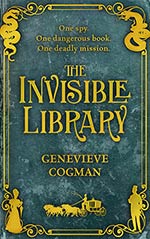
![]() thrak
thrak
4/28/2015
![]()
"That was the whole point of the Library: as far as she'd been taught, anyway. It wasn't about a higher mission to save worlds. It was about finding unique works of fiction and saving them in a place out of time and space. Perhaps some people might think that was a petty way to spend eternity, but Irene was happy with her choice. Anyone who really loved a good story would understand."
'The Invisible Library' by Genevieve Cogman is a thoroughly enjoyable Fantasy adventure featuring alternate worlds, a steampunkish setting, great detectives, fairies, dragons, strong female characters and books, not to mention a compelling central concept. In its inventive use of alternate realities as a series of settings for the ongoing conflict between rival forces of order and chaos, it harks back to classic Fantasy works such as 'Three Hearts And Three Lions' by Poul Anderson or Michael Moorcock's Eternal Champion books. It is held together by its overarching love of fiction, and its steadfast belief in the value and importance of books; that stories are worth preserving because they tell us something important about the culture that produced them, and simply for the joy a good story brings.
At the centre of 'The Invisible Library' is the Library itself, a vast, interdimensional space that a secret society of immortal dimension-hopping Librarians use to store fiction from alternate realities. It's an inspired creation, drawing on both Borges' infinite library and Edgewood, the house that acts as a portal between the worlds of humans and fairies from John Crowley's 'Little Big'. The Librarians themselves are a classic manipulative secret society, a force on the side of order but filled with dark secrets and arcane power games. Appropriately for a book about libraries, 'The Invisible Library' treats fiction as its playground, cheerfully mixing up Moorcockian Fantasy in its use of alternate dimensions and sinister, chaos-worshiping Fae, the Sherlock Holmes stories beloved of protagonist Irene in the form of the great detective Vale, and the scientific romances of H. G. Wells and Jules Verne in its steam-powered, Victorian-esque London. There are even elements of Lovecraftian cosmic horror in the villain Alberic, a rogue Librarian who has turned to the side of chaos to sustain his immortality. Cogman meshes all these disparate elements together seamlessly, and the book has gonzo invention to spare with its giant mechanical insects and clans of warring werewolves, vampires and fairies. It recalls the mad alchemy of the original steampunk novels by Tim Powers, James Blaylock and K. W. Jeter, rather than the more tired and cynical trappings of the genre that have been overused since.
In keeping with the book's faith in the power of language, the Librarian's magical powers stem from language itself. The Librarians can speak the Language and force the physical components of reality around them to do their bidding, a literalised form of reification, which links thematically back to Borges. Cogman makes good use of the concept, exploring both the limitations of the technique - you have to phrase your requests very specifically for it to be useful, thus limiting its use as a 'get out of jail free' card for the heroes - and the extent to which it could be abused, in a troubling scene in which Irene uses the Language on a person to hijack an airship.
As well as an intriguing set-up, 'The Invisible Library' also has well drawn and memorable characters. Vale, the Holmes-esque detective and Kai, Irene's assistant, trainee and secret dragon in human form, are compelling characters, all the more so for having the ability to act against Irene's and each other's interests when appropriate. Much of the philosophical weight of the book comes from Irene's attempts to keep Vale on her side. Vale is a rational and caring person who believes that the Library should use its powers to help people rather than just preserving books. One of the good things about 'The Invisible Library' is that, while the Librarians are unquestionably on the side of order, this does not necessarily mean that they are all good or nice; some of the Librarians will use any means necessary to acquire the books they are after, no matter how damaging the consequences to bystanders. We see this personified in the most interesting relationship in the book, between Irene and her ex-mentor Bradamant. Bradamant cares about completing her mission at any cost, and has thrown Irene under the train in the past to achieve this; as a result, Irene is especially conscious of how her actions affect other people, and wants to do her job without causing harm and to help people on the way if she can. Irene has to prove that she can get results whilst showing Vale that she is ultimately a moral person, unlike Bradamant. Cogman handles Bradamant and Irene's relationship very well; there's no denying that Bradamant is incredibly selfish, manipulative and unpleasant, even going so far as to drug Irene at the climax so that she can finish the job her way without Irene's interference, but she isn't the main villain, and by the end of the book there's a sense that she has learned to respect Irene, whilst Irene, by showing that she is both moral and competent is able to leave behind her hangups about being in Bradamant's shadow.
http://goldenapplesofthewest.blogspot.co.uk/2015/04/genevieve-cogman-invisible-library-2015.html